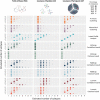Clinical subtyping using community detection: Limited utility?
- PMID: 36415153
- PMCID: PMC10242199
- DOI: 10.1002/mpr.1951
Clinical subtyping using community detection: Limited utility?
Abstract
Objectives: To discover psychiatric subtypes, researchers are adopting a method called community detection. This method was not subjected to the same scrutiny in the psychiatric literature as traditional clustering methods. Furthermore, many community detection algorithms have been developed without psychiatric sample sizes and variable numbers in mind. We aim to provide clarity to researchers on the utility of this method.
Methods: We provide an introduction to community detection algorithms, specifically describing the crucial differences between correlation-based and distance-based community detection. We compare community detection results to results of traditional methods in a simulation study representing typical psychiatry settings, using three conceptualizations of how subtypes might differ.
Results: We discovered that the number of recovered subgroups was often incorrect with several community detection algorithms. Correlation-based community detection fared better than distance-based community detection, and performed relatively well with smaller sample sizes. Latent profile analysis was more consistent in recovering subtypes. Whether methods were successful depended on how differences were introduced.
Conclusions: Traditional methods like latent profile analysis remain reasonable choices. Furthermore, results depend on assumptions and theoretical choices underlying subtyping analyses, which researchers need to consider before drawing conclusions on subtypes. Employing multiple subtyping methods to establish method dependency is recommended.
Keywords: community detection; hierarchical clustering; k-means; latent profile analysis; psychiatric subtypes.
© 2022 The Authors. International Journal of Methods in Psychiatric Research published by John Wiley & Sons Ltd.
Conflict of interest statement
The authors have no conflict of interest to declare.
Figures




References
-
- Barabási, A. L. (2016). Network science. Cambridge University Press. - PubMed
-
- Bathelt, J. , Holmes, J. , Astle, D. E. , Gathercole, S. , Astle, D. , Manly, T. , & Kievit, R. (2018). Data‐driven subtyping of executive function–related behavioral problems in children. Journal of the American Academy of Child & Adolescent Psychiatry, 57(4), 252–262. 10.1016/j.jaac.2018.01.014 - DOI - PMC - PubMed
Publication types
MeSH terms
LinkOut - more resources
Full Text Sources

